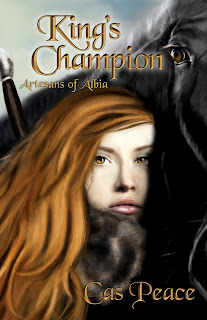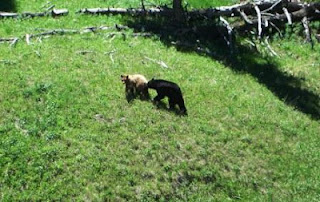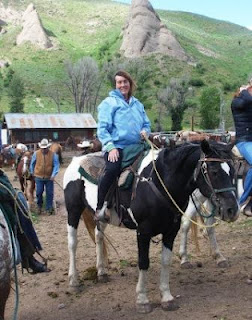5: Wait!
This is the hard bit. If your target’s stated wait time
elapses, it is acceptable to make polite contact and ask for a status update.
Make sure you include the correct references so the agent or publisher knows
who you are. If you still receive no reply, and the time goes way over, then forget
this one and move on. Magazine submissions are different, many magazine editors
will keep stories or articles until they think the time is right to publish
them. Usually, they will tell you this, but not always. If you get fed up and
want to submit your work elsewhere, you MUST write and let them know.
6: Note on Research:
While you are researching publishers and agents, do remember
that THEY might also research YOU. Publishing is a relationship, and both
parties need to know they can work happily with each other. Social media makes
it easy for publishers and agents to research writers. If you have ever been
online or joined any kind of social network, you can be traced. Even if the
network was taken down, or you deleted your online profile. Such information
NEVER disappears from the web. Be professional at all times. NEVER vent spleen
online at anyone in the writing industry, or anyone else for that matter. It is
too easy to acquire the wrong reputation. When you are rich and famous you might
be able to get away with bad-mouthing people, such things can even result in
publicity and increased interest, wrong though that is. But if you are a
beginner in the industry, avoid doing anything that could label you a rebel,
difficult to work with, or prejudiced. You should try to cultivate a
professional online presence.
7: Rejections.
Develop Rhino Hide!
The time spent waiting for a response to your submissions is
a good time to develop a really thick
skin. Because unless you are phenomenally lucky, you will receive many
rejections. DO NOT TAKE THEM PERSONALLY. We all get them. Unless you’re a celebrity
or have done something truly fantastic, you will be rejected. Publishing
success is often a case of submitting to the right place at the right time. Editors
change all the time and the publishing house that turns you down one year might
accept you the next, purely because they have a new editor.
Do not expect personal responses. Most agents/publishers use
stock rejection letters. It simply saves them time. They are busy people, yes –
but it is good to remember who it is that enables them to be busy. You and me:
Writers. So keep trying!
If you are lucky enough to get personalized rejections, take
good note of what they say. Agents and publishers do not have to do this, and when
they do it is often an indication that you are doing something right. If they
make any specific comments on your work, think very carefully before ignoring
them. These are industry professionals – they know what they are talking about.
During my own submitting experience, I received many personal responses from
agents and publishers. All of them praised my work, all encouraged me to keep
submitting. This was hugely uplifting, but also highly frustrating! However, it
did galvanize me to carry on, and I now know why I didn’t achieve success in
those early years. Not only was my novel not quite perfect enough, but the
perfect publishers for me didn’t then exist. They do now, and I am so pleased I
wasn’t offered a contract by anyone else.
Beware!
If you are rejected, do not enter into tit-for-tat
discussions. I once replied to an agent who had read all three books in my first
trilogy yet still rejected me. It was my own fault – I had convinced myself she
would take me on simply because she’d invested so much time in reading. I sent the
letter with the most innocent of intentions, yet received a quite vitriolic return
email branding me “the very worst kind of author”. It reduced me to tears, because it was so untrue.
I simply couldn’t understand why this had happened but when I calmed down and
re-read the email I’d sent, I could see how it could be misconstrued. Remember,
when sending emails, that the recipient cannot hear the tone of your voice. A
little joke could be read as criticism, a question can come across as an
arrogant statement.
So – no knee jerk reactions to rejection letters. Take a
deep breath, use that rhino hide and start again. Be positive. Success comes to
successful people because of their positive attitude. If you are not positive
about your work, why should anyone else be?
8: Agent Acceptance.
Here I have no personal experience, as I do not have an
agent. But the situation will be similar to acceptance by a publisher. Make
sure that you like the agent and can work with him/her. You will have to develop
a close working relationship and trust them to know their job. Read the
contract carefully and get someone to help you if you’re not experienced with
contracts. Make sure there is a mutual ‘get out’ clause if the relationship
breaks down, or you don’t like the agent’s work.
9: Publishing Acceptance!
Wow! Be excited, be proud. Do your screaming and celebrating
in private, so you can be calm and professional when speaking to your
publisher. You will be offered a contract, so go through it carefully or show
it to someone who knows about them. In the UK, anyone who has a firm offer from
a publisher is eligible to join the Society of Authors http://www.societyofauthors.net/
and they can help with advice on contracts. Be aware, though, that they might
not be definitive if your offer is from a US publisher, or any country other
then the UK. If you are not happy with the level of royalty you are offered, or
anything else in your contract, don’t be afraid to negotiate (in as
professional a manner as possible). Do though, be prepared to have to sign it
as is.
Don’t expect an advance for your book. Generally speaking, those
days are over. Only celebrities get advances now.
Treat all your publishing dealings as a business. Keep
meticulous records of any costs you incur as an author, such as for professional
photographs, business cards, or travel costs. Try to speak with your publisher
in person, by phone or Skype; emailing is not ideal unless it’s for something
simple. Your manuscript will be copy edited and some editors may suggest
revisions. They will know what’s best for your book, so accommodate them unless
there’s a really good reason not to. Always discuss your thoughts, concerns and
ideas. Your publisher now owns your book – work with them to make it a success.
If you are permitted input into your cover image, book layout,
etc, then consider yourself fortunate. Do listen to your publisher if they have
a firm idea for the cover, even if you don’t like it. They will have a better
idea of what kind of covers sell books than you do.
Royalties will vary between publishers, and also between different
book formats. On a sliding scale, you can typically expect to be paid between
6% and 15 % of sales. The percentage will depend on whether it’s a print book,
an ebook or an audio book. Do not expect to immediately make a living from your
sales! It can take quite a while for a new author to build up a fan base.
10: Marketing.
Things have changed in the publishing industry as they have
elsewhere, and marketing budgets for new, unknown authors have suffered. These
days, we are all expected to help market our own books, even authors published
by one of the “Big 6”. If you can accept this right from the start, and begin
thinking up ways to market yourself and your book, you will be ahead of the
game when that all-important contract comes your way. An author who can bring
good marketing ideas to the table will be considered an asset by a publisher.
But where to start? If you can, identify your novel’s USP
(Unique Selling Point). If you really can’t find one (and if you can’t, chances
are neither will your publisher, so you may not get a contract) try to find a
personal one, something related to you as an author.
I will give you an example. My USP is singing. That’s
not unique, I know; I’m sure many authors can also sing. But how many do you
know who have both written and recorded songs that are associated with their
novels? Not many, I bet! My fantasy novels are set in a medieval-style world
and in that era singing was a popular and respected form of entertainment. It
was natural for me to include references to singing in my books, and my main
female character is a singer. King’s
Envoy actually includes a song in poem form, and so I made use of my
musical brother and his song-writing partner to help me put a melody to the
poem and record it as a song. “The Wheel Will Turn” is available on my website
and my publishers’ as a free download, and it will soon be joined by “The
Ballad of Tallimore”, the song from King’s
Champion. We performed “The Wheel” live in a shopping mall at the launch
for King’s Envoy, and I have used it
to gain interest from various radio stations, who then aired interviews and
played the song.
This is just an example. What can you use, either from your
book or your personal life, to help promote your work?
As an author, I’m often asked about Facebook and Twitter,
and whether writers need a website. My answer is: Can you afford to ignore
these great marketing platforms? I don’t think so. However, your involvement
with them can be as little or as much as you want. Don’t let them rule you. I
do use Facebook (although I can’t get to grips with Twitter!) and I do have a
website. I think they are essential for allowing readers to connect with you.
If they are interested in you as a person, they are more likely to buy your
books. I also contribute to writers’ forums and swap interviews on blogs. I
have a blog of my own (clearly, since you are reading this!). The internet is
so much a part of our lives these days that I do believe even the older writer
should learn how to use it to their advantage. For those who really can’t face
it, do you have a younger family member who could be persuaded, coerced, or
bribed into doing it for you? It’s something to think about.
Book signings are another good way for authors to connect
with readers. If you approach them professionally, many bookstores will be
happy to host you. Libraries are also good places to hold signings. Give talks
to writers’ groups and even schools, if your books are appropriate. Don’t
forget local papers and radio stations – you don’t need to have a song to get a
radio interview!
Marketing need not be an albatross about your neck.
Connecting with other writers and potential readers can be fun, and very
rewarding.
11: Write More
Books/Stories/Letters!
The best way to get your name “out there” and create a
reader fan base is to Write More Books. Don’t rest on your laurels if you
achieve publication – keep those creative juices running by continuing to
write. The more readers hear your name and the titles of your books, the more
likely they are to buy.
Good luck!
12: Self-Publishing.
If the goal of “traditional” publishing fails you, then
there is always the self-publishing route. This is not necessarily second best,
and it is losing some of the stigma it first had. However, there are
undoubtedly some very bad self-published books out there. I do not propose to
go into great detail about the various self-publishing methods or sites here –
it is too wide a subject – but I would certainly not discount self-publishing.
I would have gone that route myself had I not found my own, fantastic
publisher!
What I will say is this: If you do decide to self-publish,
please remember that making your writing the absolute best it can be is more
important than ever. You will not have the advantage of an editor, so PLEASE
hire one (a good one!) to proof your novel. So many times I’ve seen an
otherwise great book receive a mediocre review because the writer either failed
to realize he wasn’t good at spelling, grammar, sentence structure or plotting,
or because he simply thought readers wouldn’t care. If you want people to pay
good money for your work, you HAVE to give them value for it. Writing is a
business – be professional and don’t let yourself or your work down!
FOOTNOTE:
As well as being an author, I’m also a freelance editor and
proof reader. Please check out my Writers’ Services, and don’t let the thought
of high fees put you off. I believe good editing should be available to all,
and because I like to help other writers, I do not have a fixed tariff. I
prefer to agree individual fees with each client, tailored to what they can
afford. So don’t be afraid to email me and ask for a quote. Here’s the link to
my website, where you can also find testimonials from authors and writers I
have already helped.
I wish you the very best of luck, and I look forward to
working with some of you.
Cas Peace.
Cas Peace.






























